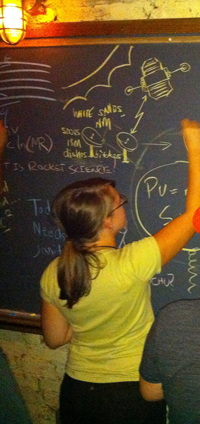
The order of operations includes two types of rules: those that are based on the way the operations work, and those that are arbitrary. My friend @harrisonalg from the Twitter chat #mathchat and I have been discussing this.
You can explain the truly arbitrary elements of PEMDAS (the left to right of AS and MD) through an experiment. Allow students, independently, to do these two problems any way they want, ignoring any stupid arbitrary rule they might have previously memorized:
- 3 – 2 + 8 – 3 + 4
- 2 x 7 ÷ 2 x 6 ÷ 3
The idea is that they will come up with many different answers:
- 3 – 2 + 8 – 3 + 4 could be any of -14, 0, 10 or others
- 2 x 7 ÷ 2 x 6 ÷ 3 might be 7/18, 7/2, 14, etc.
If they were on a team building a bridge with these calculations, things wouldn’t work so well.
Enter the Stupid Arbitrary Rule (SAR).
Because we need to all come up with the same answer, we need a rule to follow. Really, it can be any stupid arbitrary rule (SAR). But we agreed, at some point in history, to all follow the “left to right” thing once we were down to addition & subtraction or multiplication & division.
It’s important to note that kids didn’t get to be part of that agreement we made. Just like they don’t get to vote in elections.
Is it fair? Probably not. They would probably do a better job of choosing leaders as well as determining the order of operations. But that’s the way things likes SARs work.
PEMDAS doesn’t cover it all!
To throw a few more kinks into it, check out how wikipedia explains some special cases of the order of operations. . Factorials aren’t covered in PEMDAS, neither are the order of exponents.
Here’s another fun one: even calculators do things differently (and arbitrarily). Check out the way the the TI-92 and the TI-30XII handles exponents. Clearly you get to make up your own order of exponents!
Let them play king: they create the rules!
Let your students determine the order of operations for addition & subtraction and multiplication & division – just for the class. Make sure to write the rule down and tack it to the wall so everyone remembers what they decided. In your class, and your class only, they are to follow that rule.
Remember the back of the book, as well as your answer keys or teacher edition textbook, will now be totally wrong. But it’s worth it.
Doing it this way they might start to understand which pieces of PEMDAS are dependent upon the way the operations are constructed () and which pieces of PEMDAS are arbitrary (left to right).
Once the class determines their special arbitrary rule, practice creating expressions whose result is some important number. Some options could be:
- The age of one of the kids
- Someone’s favorite number
- Your age (be careful)
- The age of some other grown-up they know
- The last four digits of their phone number
- The number part of their street address
Create the expression using the Class Rule as well as the stupid arbitrary rule. Then translate and have a good laugh. I just did my age with my “Bon Rule.”
Bon Rule: addition and subtraction go from left to right, and multiplication comes before division.
My age is 120 ÷ 2 x 3.
If I did this according to the SAR, I’d be dead. Or really famous.
Your turn!
Can you teach the order of operations like this with your kids? If you classroom school, how much trouble are you going to get in when you become the math teaching rebel?
Share your experiences in the comments!
Related articles
- The Order of Operations Explained
- We Use Math and Grammar Rules – They Don’t Use Us!
- 3 Words to Improve Your Child’s Success in Math
- Why the Law of Sines Sometimes Doesn’t Work Right

This post may contain affiliate links. When you use them, you support us so we can continue to provide free content!







This is ridiculous. Sure, let’s teach children to do it in away that they get a completely different answer from what they will need to get when out in the world. That way, they will be completely confused on what the “agreed upon” way is. I’m not buying your argument.
Fair enough, JG.
And that’s a normal response from people who live in a world where we start crushing novel thinking and curiosity out of students in the first grade.
I propose that we bring back novel thinking – maybe not in the 7th grade. But we must stop teaching 1st graders that there is a RIGHT answer rather than various ways to get AN answer.
So, it’s more important to preserve erroneous “novel thinking” than educating children how to do things the way the world actually works? Is that what you’re saying? That it’s more important they can make up their own rules to get ANY answer, than follow the established ones to get the RIGHT answer?! That’s absurd!
Yes, Kaitie-Lynn, if you want to over-simplify it. The fact is that getting the right answer isn’t what employers want. It’s being able to think.
And “the way the world actually works” is that there isn’t many times when there is a right answer.
Making up your own rules (and figuring out which of yours will work with everyone else’s, and which won’t) IS the way of the world.
I’m with JR on this one. I think the risk that students will get confused and not remember which is the agreed order of operations is too high.
On the other hand, having a discussion about the fact that the rule is really arbitrary is quite healthy, I think. That is the sort of thing I wish my teachers had taught, rather than making feel like I must be stupid if I didn’t understand why the rules are the way they are.
That “making me feel like I must be stupid” tactic is exactly how grownups work to eliminate the novel thinking in young kids.
So damaging.
Thanks for stopping by, Peter.
🙂
As a freshmen math teacher, I have students who have been exposed to PEMDAS before but always seem to forget the rules. So to begin the lesson I have pairs of students work on different problems, stating each step. Once completed they share with the class their steps and thought process. Other groups cannot comment until all groups have presented. Then we discuss why would anyone put parenthesis first (because it is grouped and a good starting place). We discuss the rules as created thousands of years ago so that we all can compute the same answers no matter where we live. Students then practice the correct way and once understood create their own rules, create a problem and have a friend solve it. No one is confused and they realize we all need to agree on one set of rules to function world wide:)
Brilliant!
As a high school teacher you’re having to manage years of “math baggage” of incoming students. If it was negative, or some topics were not firmly learned in a positive way, you’re faced with a huge challenge.
It looks like you’ve figured how to make it work. That’s so awesome to read – thank you for sharing this method!
I struggled for years in math because not once did any of my teachers understand my frustration at how “made up” these kinds of maths were. They’d repeat the lines from the book, give us the tests, and wait for summer. Having really shitty teachers does a disservice to mathematics.
Now, as a fully grown man with a doctorate in mathematics, I can say with pride that my confusion wasn’t because I was too stupid to understand it (in fact what was responsible for my problem learning it was a keen and rare philosophical insight which I would later go on to write about in my doctoral dissertation!) but rather it was due to having crappy teachers not give a crap about their children’s /understanding/ of the material. In a school system where grades matter more than understanding, the child will fail every time; he’ll fail even if he graduates.
Good math teachers connect with and create understanding in their students. Kudos to you, Bon, for breaking the poor mold imposed on teachers. By doing this you’re giving your kids a fair chance at exploring the beauty of the world of mathematics. No regrets in that.
Good on you,
Adam S.
Thanks so much, Adam, for sharing your story and for the kind words. I’m certainly looking forward to perusing your dissertation – you have me curious!
I realize you wrote this blog entry 2 years ago, so my comment is hardly timely. However, the PEMDAS algorithm is not at all arbitrary.
I’ll grant you PEMDAS is difficult for students to remember and that it causes quite a bit of frustration. However, allowing them to do it any other way isn’t about allowing student decision making or ‘not crushing novel thinking’. Doing so will only damage their ability to understand math.
Like it or not, math is a logical structure with firm rules. Progress in understand comes from mastering the rules and understanding their interactions.
The priority of the order of operations is not arbitrary. It exists because some operations are shortcuts or condensations of others. Multiplication has a higher priority than addition because multiplication is condensed addition.
3 + 2 x 5 = 13, not 25, because 2 x 5 is actually 2 + 2 + 2 + 2 + 2. So 3 + 2 x 5 = 3 + 2 + 2 + 2 + 2 + 2. By expanding the problem, the students can see that multiplication is merely a shortcut for addition.
If you let the students do 3 + 2 x 5 as 3 + 2 = 5 and 5 x 5 = 25, there is no way you can show them how to expand the multiplication as addition.
Worse yet, allowing ‘choice’ in order of operations will kill the students ability to see patterns because terms will not have consistent values. If 3 + 2 x 5 = 13, then 4 + 2 x 5 = 14 because we are merely adding 1 more, which can be shown as 1 + 3 + 2 x 5. But the other way gives 4 + 2 = 6 and 6 x 5 = 30, which is not 1 more than the wrong answer of 25 we got from doing doing the first problem the wrong way.
Exponents come before multiplication for the same reason. Exponents are condensed multiplication so in an expression like 3 x 2^5, doing the multiplication before the exponents means you cannot expand the the expression. 3 x 2^5 = 3 x 2 x 2 x 2 x 2 x 2 = 96. If 3 x 2^5 = 3 x 2 = 6 and then 6^5, how can you show the expansion? 6 x 6 x 6 x 6 x 6? Where did all the 6’s come from?
I understand your desire to create student engagement and reduce frustration, but in this case you are just wrong. Teaching the students that PEMDAS is a social justice matter in which they have been deprived of their choice does nothing but mathematically handicap them.
Well, John, I’m pretty sure PEMDAS (regardless of how you feel about it) is not going out of fashion any time soon – so your timing is still good!
There are many good reasons for the order of operations. But there are some serious problems with forcing the PEMDAS mnemonic. Even if we decide that it’s not arbitrary, it still leaves out roots, logs and absolute values.
And I think Keith Devlin might take up the argument of multiplication being repetitive addition: http://www.maa.org/external_archive/devlin/devlin_01_11.html
This here is why I insist that the only reason math exists is because at some point, some very practical individual needed some way to solve a real-world problem. From there, it did delve into the abstract and invented problems yielded higher math which, again, has practical applications. The trick is to know what you’re given, acknowledge what you’re assuming, and from there, estimate what is expected of you.
So now, how do you solve 3 + 2 * 5?
The real question is what does 3 + 2 * 5 even mean? It’s quite obviously shorthand for something. Is it shorthand for 3 oranges + 2 oranges/pair * 5 pairs of oranges? Is it 3 oranges/batch + 2 oranges/batch * 5 pairs? Which makes more sense for it to be abbreviating? Unless these numbers represent something, there’s no point in solving it and there’s no way of understanding what the solution even means.
This is why I insist that word problems are the ones that should be taught. The rest is convention. Yes, as much as you want to you can say convention is artificial, but it is an important thing when dealing with communication, including traffic signals (why is RED the color to signal a stop, and GREEN the color to signal that it is appropriate to proceed?) and which side of the road we drive on and what “flammable” and “inflammable” mean and why we use a new word “nonflammable”.
I would love it if parents and teachers comprehended that units are of the utmost importance in learning and applying mathematics at any level.
Nicely put, Derek!
I taught at Halliburton for a while (wrote the Oilfield Math textbook too) and that was the BIG thing. If you don’t have the units, it’s all useless.
Thanks for stopping in and sharing!
Hi Bon.
Interesting read. Thanks.
I recently became interested in the subject of arithmetic order of operation after taking a test on Facebook, which I failed. I failed because I worked from left to right. I didn’t take into account this thing called BODMAS. I’m an electronics engineer and I’ve been solving long, complicated equations on a regular basis for many years. It had me a little concerned that I’d never heard of BODMAS or arithmetic order of operations before. How can this be? I’ve done a lot of research and reached the conclusion that I’ve gotten away with it so the same reason that 80% of people failed the Facebook test – no-one really ever uses it. (At least, most of it).
What I have discovered from my research and many conversations is that people are on one side of the fence or the other. It’s been difficult for me to persuade either side to see the other. It’s incredible how loyal people are to their beliefs.
So, let’s clear a few things up… one of the arguments i have heard a few tines is “you need to have rules”. I think it’s safe to say that we all agree that we need rules. We all need to be following the same processes to avoid a mighty. I’m also confident that we can all agree that this is a rule that was decided upon a long time ago, as the method that we will all use. That’s all it is – the one way that was chosen – one way of many possible ways. Now… MY argument is that I do not believe that it is the easiest / most logical way.
Next, I’d like to point out an obvious flaw in the BODMAS rule: BRACKETS first – no problem… Of – huh?… DIVISION – ok… MULTIPLICATION – the acronym implies that division comes first, whereas it has equal power to multiplication, you solve them from left to right. The same is true for ADDITION / SUBTRACTION.
This is not a straightforward rule. We need to remember an order, and that some of the operators have equal power. If you come across 2 together, there is an exemption that we will now work left to right.
Another common excuse I’m given for using this rule is that it means you don’t have to put brackets everywhere… even with this rule, brackets are still frequently required. This rule hasn’t added much value yet.
I’d also like to counter the fans of this rule out there that talk about the wrong way and the right way. Just bare in mind that 80% of people do it the “wrong” way. Remember why we have this rule? So that we can all follow the same process.
There is one final thought I’d like to discuss from my research. I’ve heard the exact same statement from 2 different people. “You can’t just go making up rules just cos it suits you!” Why not? How did we get BODMAS in the first place? If the complaint is actually meant to be ” you can’t go changing rules…” then again… why not? How come women vote? How come gays get married? Because we realised that the old rules didn’t work anymore.
Lastly, regarding John’s post:
This is a fine example of being firmly planted one side of the fence. John raised some points which don’t take much imagination to answer. Such as: “there is no way to show them how to expand the multiplication as addition.” Sure there is. You just did it. Simply apply the expansion technique that youve demonstrated to the 5’s. 5x5x5x5x5. Simple. You also said “where did all the 6,s come from?” Another simple answer: the same place all your 2’s came from earlier.
I move to replace the order of operations with a simple left to right rule. If an equation solved in thus order does not achieve the answer you wanted, I put it to you that you must have written it in the wrong order.
That said… I’m keeping an open mind. There might be someone who can actually demonstrate to me that the current rule is better that left to right.
Pete
You refer to BODMAS (which I do not see mentioned anywhere in this article or any comments). I believe you might be thinking of BEDMAS instead, which is brackets, exponents, division, multiplication, addition, and subtraction. (That explains your look when assuming that O stands for “of”.)
Processing division before multiplication has no effect on processing multiplication AND division as it comes across from left to right.
a*b*c/d*e*f, when processed left to right (as a spreadsheet does) gives you the same result as a*b*c*e*f/d. Processing division first gets you a*b*(c/d)*e*f which gives you the same result. However, processing multiplication first (which one might argue that PEMDAS implies) gives you (a*b*c)/(d*e*f) which yields a different result. For this reason, I prefer BEDMAS for stuff like spreadsheets.
However, reading 1/2x with BEDMAS in mind, you should get x/2. This reading would be rarely expected in such a small equation.
Thanks for stopping in, Derek!
In fact, the O is for “orders” – like powers or exponents.
Regarding your comment “I move to replace the order of operations with a simple left to right rule. If an equation solved in thus order does not achieve the answer you wanted, I put it to you that you must have written it in the wrong order.”
Consider the problem where we have 2 groups of 5 oranges, one pair of two oranges, and 6 groups of 7 oranges. Using PEMDAS or BEDMAS, we can compute this as 2*5+2+6*7. In what other order can we calculate the total number of oranges? Reading it with BEDMAS or PEMDAS, we get 10+2+13=25.
Reading it left to right, we get 10 from the 2*5, add 2 for a subtotal of 12 so far, add 6 for a subtotal of 18, and multiply that by 7, we get 126, which makes no sense at all.
You claim to be an electronics engineer. I’m afraid I have to call you out on that.
Wow. I must correct myself.
2*5+2+6*7 = 10+2+42 = 54. 54 oranges.
In addition, one could simply use brackets. [2*5]+[6*7]+[1*2]
Well. All of this is so confusing for us Grandparents trying to help our Grandkids complete math homework when we were taught a very different way to solve equations! So I just give up and the teachers or whoever decided to change the rules can help my Grandkids with their homework😕
I just cant come up to a mathematical problem were you won’t use brackets and parenthesis on a practical aplication. When we equate a problem we were to group the, right?